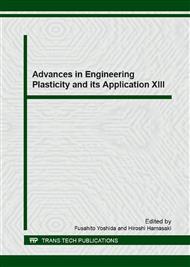p.548
p.554
p.560
p.566
p.572
p.578
p.586
p.592
p.598
Wear Mechanism and Ability for Recovery of Tool Steel on Blanking Die Process
Abstract:
Tool steel grade JIS; SKD-11 is a well-known raw material for making a high wear resistance of blanking tool in stamping industry. One problem in the blanking process is the high cost of raw material for making punch and die. Therefore, in this study, behavior of wear phenomenon and ability of recycle on the punch of blanking die process were investigated. In the first section, phenomenon and mechanism wear of blanking punch were observed. We found that mechanism of wear on blanking punch was adhesion wear, since high amount of chromium content in the punch has compatibility of elements. The second section, recovery punch was designed by annealing, resize and quenching process by using the new punch from the first section. From the recovery punch results, it was found that the wear resistance of recovery punch decreased slightly but it was strong enough to continue in blanking process. However, the recycle process of tool steel depends on a quality and amount of the product.
Info:
Periodical:
Pages:
572-577
Citation:
Online since:
December 2016
Authors:
Keywords:
Price:
Сopyright:
© 2017 Trans Tech Publications Ltd. All Rights Reserved
Share:
Citation:


